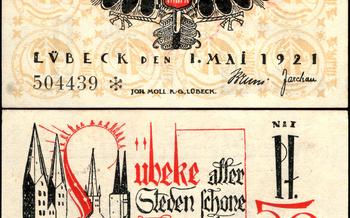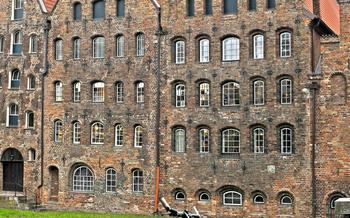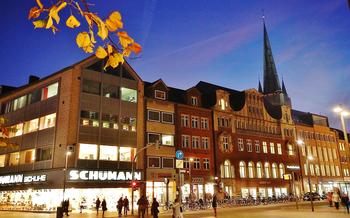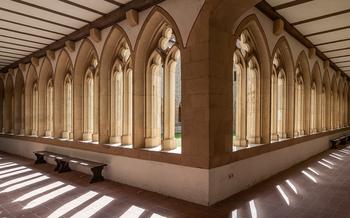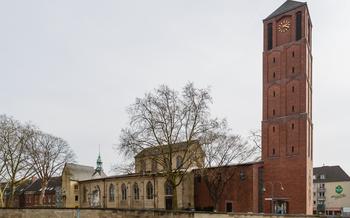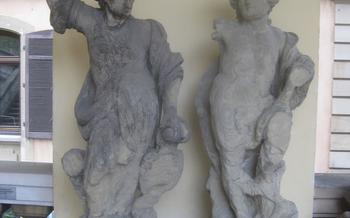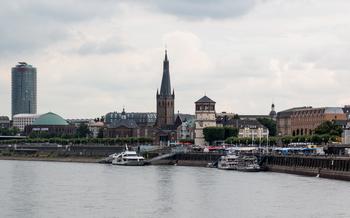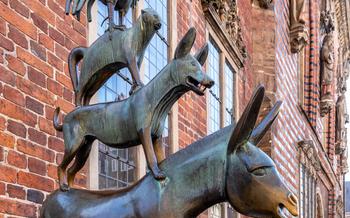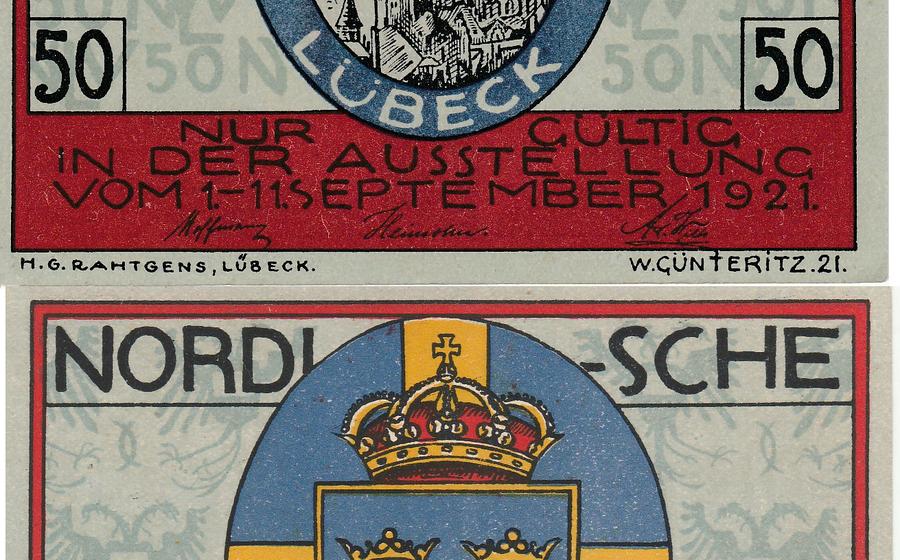
Kloster Cismar
- Kloster Cismar: A Historic Gem
- Exploring the Monastery Grounds
- The Monastic Church
- The Chapter House
- The Refectory
- The Dormitory
- The Library
- The Scriptorium
- The Cloisters
- The Gardens
- Anlage von Gärten und ihre Bedeutung
- Kräutergarten und Heilpflanzen
- Obst- und Gemüsegarten
- Ort der Erholung und Selbstversorgung
- The Workshops
- The Infirmary: A Haven of Healing
- The Cemetery
- Events and Exhibitions
- Insider Tip: Off-Season Visit
Kloster Cismar: A Historic Gem
Nestled in the serene countryside of Schleswig-Holstein, Germany, lies the enchanting Kloster Cismar, a Cistercian monastery that has stood the test of time. Founded in the 12th century by monks from the renowned abbey of Esrom in Denmark, this architectural gem has played a pivotal role in the region's spiritual, cultural, and historical tapestry for over 800 years.
The monastery's rich history is intertwined with the rise and fall of empires, religious reforms, and the shifting political landscape of Northern Europe. In its early years, it flourished as a center of learning and piety, attracting monks and scholars from across the region. Over the centuries, it faced challenges and transformations, including the Reformation, when it was secularized and its lands were divided among the local nobility.
Despite these trials, Kloster Cismar's architectural splendor and cultural significance remain intact. Its well-preserved Romanesque and Gothic structures, including the imposing monastic church, the Versammlungssaal, and the cloisters, showcase the architectural prowess of its medieval builders. The monastery's storied past and ongoing role as a cultural hub make it a must-visit destination for history buffs, architecture enthusiasts, and pilgrims seeking tranquility and inspiration.
Exploring the Monastery Grounds
The Kloster Cismar complex is a captivating blend of architectural styles, reflecting its rich history and diverse functions. As you wander through the grounds, you'll encounter a harmonious arrangement of chapels, cloisters, gardens, and courtyards, each contributing to the monastery's serene and contemplative atmosphere.
The chapels, adorned with intricate carvings and stained glass windows, invite visitors to immerse themselves in the spiritual essence of the monastery. The cloisters, with their graceful arches and delicate tracery, offer a tranquil setting for meditation and reflection.
The gardens, meticulously landscaped with colorful flowers, fragrant herbs, and fruit trees, provide a vibrant contrast to the austere architecture. These serene spaces were not only aesthetically pleasing but also served a practical purpose, as they supplied the monastery with fresh produce and medicinal plants.
Courtyards, enclosed by the monastery's buildings, create intimate and sheltered spaces. These areas were used for various activities, such as work, relaxation, and socializing, fostering a sense of community among the monks.
As you explore the monastery grounds, take a moment to appreciate the intricate details and harmonious balance of the architecture. The combination of Gothic, Romanesque, and Renaissance elements creates a visually captivating landscape that transports visitors back in time, offering a glimpse into the rich history and spiritual traditions of this remarkable monastery.
The Monastic Church
The Kloster Cismar's monastic church stands as a testament to the architectural prowess of the Gothic era. Its towering spires, intricate carvings, and stunning stained glass windows create an awe-inspiring sight that captivates visitors from the moment they step inside. The church's interior is a treasure trove of religious art and artifacts, with altarpieces, sculptures, and paintings that depict scenes from the Bible and the lives of saints. The sense of spirituality that permeates the air is palpable, inviting visitors to pause and reflect on the deeper meaning of life. Whether you are a history buff, an art enthusiast, or simply seeking a place of tranquility, the monastic church is a must-see destination within the Kloster Cismar complex.
The Chapter House
Versammlungssaal und Einblicke in das Klosterleben
The Chapter House, known as the Versammlungssaal, holds a significant place within the monastery complex. It served as a primary meeting space for the monks, providing a venue for discussions, decision-making, and the administration of the monastery. Throughout history, crucial meetings took place within these walls, shaping the course of the monastery's governance and spiritual direction.
Today, the Chapter House stands as a testament to the monastic life. Visitors can explore this historic chamber, gaining insights into the decision-making processes and daily operations of the monastery. Various artifacts and documents related to the monastery's history are displayed, offering a glimpse into the lives of the monks who once inhabited these sacred grounds.
The Refectory
The refectory, or dining hall, of Kloster Cismar is a captivating space that offers a glimpse into the monastic life of the past. This medieval dining hall, with its long wooden tables and benches, once served as the communal eating area for the monks. Immerse yourself in the atmosphere of this historic setting, where the monks gathered to share meals and engage in conversation.
Today, the refectory has been transformed into a captivating exhibition space, showcasing artifacts and exhibits that shed light on the daily lives of the monks. Learn about their dietary habits, the significance of fasting, and the role of food in the monastic community. Through interactive displays and informative panels, you'll gain a deeper understanding of the culinary traditions and practices that shaped the lives of these holy men.
In addition to its historical significance, the refectory occasionally hosts events and concerts, creating a unique and immersive experience for visitors. Whether you're attending a medieval-themed banquet or listening to enchanting melodies in this atmospheric setting, you'll have the opportunity to connect with the spirit of the monastery in a truly special way.
The Dormitory
Einblicke in das klösterliche Leben
The dormitory at Kloster Cismar offers a glimpse into the lives of the monks who once resided here. The simple furnishings and austere atmosphere convey the sense of humility and devotion that characterized their existence. Visitors can wander through the narrow corridors and peer into the small cells, each of which was home to a single monk. The dormitory serves as a reminder of the sacrifices and discipline that were integral to the monastic way of life.
The dormitory was a place of rest and contemplation for the monks. It was here that they would retire after a long day of prayer, work, and study. The simplicity of their accommodations reflects the belief that material possessions were of little value compared to the pursuit of spiritual enlightenment.
The dormitory is one of the most evocative and atmospheric spaces within the monastery complex. It invites visitors to imagine the lives of the monks who once walked these halls and to connect with the history and spirit of this sacred place.
The Library
The Kloster Cismar houses a remarkable library, a treasure trove of knowledge and wisdom accumulated over centuries. The collection boasts an impressive array of books and manuscripts, meticulously preserved and cataloged. These precious volumes encompass a wide range of subjects, from theology and philosophy to history, science, and literature.
The library served as a vital center of learning and research for the monks of Cismar. They spent countless hours within its walls, engrossed in study and contemplation. The collection was meticulously curated, with each book carefully selected for its intellectual and spiritual value.
Today, the library remains a significant resource for scholars and researchers. It provides access to rare and valuable works that shed light on the intellectual and cultural history of the monastery and the region. Visitors can delve into the depths of these ancient texts, gaining insights into the minds and hearts of the monks who once called Cismar home.
This treasure trove of knowledge is not merely a collection of dusty tomes; it is a living testament to the enduring power of the written word. The library at Kloster Cismar stands as a reminder of the importance of learning, scholarship, and the pursuit of knowledge.
The Scriptorium
Schreibstube der Mönche
The scriptorium, or writing room, was a crucial part of the monastery, serving as the center of intellectual and scholarly pursuits. Here, the monks meticulously crafted manuscripts, laboriously transcribing texts, and creating intricate illuminations. These manuscripts included religious scriptures, historische Aufzeichnungen, and scientific treatises, contributing significantly to the preservation and dissemination of knowledge during the Middle Ages.
The scriptorium was typically a quiet and secluded space, often located in a separate building or wing of the monastery to ensure an atmosphere conducive to Konzentration. Inside, the monks worked at individual desks or tables, diligently copying texts using quills and ink. They employed various writing techniques, including the use of abbreviations and symbols to save space and time.
Bedeutung für die Bildung
The scriptorium played a vital role in the medieval education system. It was here that young monks received training in reading, writing, and Latin, essential skills for their religious and scholarly pursuits. The monks also engaged in the translation of texts from Greek and Hebrew into Latin, making them accessible to a wider audience.
Herstellung von Handschriften
The production of manuscripts in the scriptorium was a time-consuming and labor-intensive process. Each manuscript could take months or even years to complete, depending on its length and complexity. The monks worked with great care and precision, ensuring that the texts were accurate and free from errors. They also took pride in the artistic embellishment of their manuscripts, creating beautiful and intricate illuminations that brought the texts to life.
Einblicke in die klösterliche Kultur
The scriptorium offers visitors a glimpse into the intellectual and cultural life of the monastery. It showcases the monks' dedication to scholarship and their role in preserving and transmitting knowledge. The beautifully crafted manuscripts that emerged from the scriptorium stand as a testament to the skill, patience, and artistry of these medieval scribes.
The Cloisters
The Kreuzgang (cloisters) at Kloster Cismar are a breathtaking example of Gothic architecture. Constructed in the 13th century, these covered walkways surround a serene courtyard, creating a tranquil and contemplative space. The intricate rib vaults and graceful arches of the cloisters are a testament to the skill and artistry of the medieval builders.
This serene setting was once used by the monks for meditation, prayer, and processions. The cloisters provided a sheltered space for quiet contemplation and escape from the bustling activity of the monastery. Today, visitors can wander through the cloisters, soak in the peaceful atmosphere, and admire the architectural beauty of this sacred space.
The Kreuzgang at Kloster Cismar is a true highlight of the monastery complex. Its elegant design, historical significance, and serene atmosphere make it a must-see for anyone interested in medieval architecture, monastic life, or simply seeking a moment of tranquility.
The Gardens
The Kloster Cismar boasts beautifully landscaped gardens that serve various purposes and offer a serene escape for visitors. These gardens, meticulously arranged, reflect the monastery's commitment to self-sufficiency and harmony with nature.
Anlage von Gärten und ihre Bedeutung
The gardens at Kloster Cismar were meticulously planned and maintained to provide both aesthetic beauty and practical benefits. They served as a source of food, herbs, and medicinal plants for the monastery's inhabitants, contributing to their self-sufficiency and well-being.
Kräutergarten und Heilpflanzen
The herb garden, a treasure trove of aromatic and medicinal plants, played a vital role in the monastery's healthcare system. Monks cultivated a wide variety of herbs, each with unique healing properties, which they used to treat ailments and promote overall wellness.
Obst- und Gemüsegarten
The kitchen garden, with its rows of vegetables and fruit trees, was essential for providing fresh produce for the monastery's dining hall. The monks grew a variety of seasonal crops, ensuring a diverse and nutritious diet for themselves and their guests.
Ort der Erholung und Selbstversorgung
Beyond their practical functions, the gardens served as a place of tranquility and relaxation for the monks. They offered a sanctuary where they could retreat from their daily duties, contemplate nature, and find solace in its beauty. The gardens also provided opportunities for physical activity and manual labor, contributing to the monks' overall well-being.
The Workshops
In addition to its religious and spiritual significance, Kloster Cismar also played a vital role in the local economy through its workshops. These workshops served various purposes, including the production of goods for the monastery's own use and the creation of items for trade and sale to the surrounding community.
The monastery's workshops were diverse and included a range of crafts and trades. There was a blacksmith, who forged tools, weapons, and other metal objects; a carpenter, who crafted furniture, doors, and other wooden items; and a cobbler, who made and repaired shoes. Other workshops included a tailor, a weaver, and a potter.
The workshops were an integral part of the monastery's self-sufficiency and provided the monks with the skills and resources they needed to sustain themselves. They also contributed to the economic development of the region by providing goods and services to the local population.
Visitors to Kloster Cismar can learn more about the monastery's workshops and the crafts practiced by the monks in the Mittelalterlicher Werkstatthof, a museum dedicated to the monastery's economic activities. The museum features exhibits on various crafts, demonstrations by skilled artisans, and the opportunity to purchase handcrafted items made using traditional techniques.
The Infirmary: A Haven of Healing
Within the walls of Kloster Cismar, the infirmary served as a sanctuary for the monks and the surrounding community. It embodied the monastery's commitment to caring for the sick and providing medical assistance. The infirmary was staffed by monks who had specialized in medicine and healing practices. They relied on their knowledge of herbal remedies, traditional treatments, and spiritual guidance to alleviate suffering and promote well-being.
The infirmary consisted of several rooms, including a dispensary, a treatment room, and a ward for the sick. The dispensary housed an impressive collection of herbs, roots, and medicinal plants, carefully cultivated in the monastery's gardens. These natural remedies formed the basis of the monks' healing practices.
In the treatment room, the monks conducted examinations and administered various treatments, ranging from wound care to pain relief. They relied on their intuition and experience, combined with the wisdom of ancient medical texts, to diagnose and treat illnesses.
The ward provided a place of rest and recovery for the sick. Here, the monks offered not only medical care but also spiritual comfort and support. They believed that healing involved not just the body but also the mind and soul.
The Cemetery
The Kloster Cismar cemetery is a solemn and evocative place, where the memories of the past are preserved. Within its walls, the final resting places of the monks and other important figures who contributed to the monastery's history can be found. Each tombstone tells a story, revealing the lives and achievements of those who have passed on. Visitors can wander among the graves, paying their respects to the individuals who once called the monastery home. The cemetery also offers a glimpse into the history and culture of the monastery, as well as the surrounding region. It is a place of remembrance and reflection, inviting visitors to contemplate the transience of life and the enduring legacy of the past.
Events and Exhibitions
Kloster Cismar is not just a historical site but also a vibrant cultural center. Throughout the year, the monastery hosts a variety of events and exhibitions that bring its history and significance to life. From concerts and lectures to workshops and special exhibitions, there's always something new to discover at Kloster Cismar.
Music lovers can indulge in the harmonious sounds of classical concerts held within the monastery's walls. The acoustics of the monastic church create a magical atmosphere that enhances the musical experience. Lectures and workshops provide insights into the history, architecture, and cultural heritage of the monastery. Experts share their knowledge and engage visitors in discussions about the significance of Kloster Cismar.
Special exhibitions showcase a diverse range of topics related to the monastery and its surroundings. These exhibitions may focus on specific periods in the monastery's history, the lives of notable monks, or the artistic and cultural treasures associated with Kloster Cismar. Visitors can explore these exhibitions at their own pace, immersing themselves in the rich tapestry of the monastery's past.
Attending events and exhibitions at Kloster Cismar offers a unique opportunity to delve deeper into the monastery's history and significance. These events create a platform for visitors to engage with the monastery's heritage, appreciate its cultural offerings, and gain a deeper understanding of its role in the region.
Insider Tip: Off-Season Visit
Visiting Kloster Cismar during the off-season, typically from November to March, offers a unique and serene experience. The number of visitors dwindles, creating a tranquil atmosphere that allows for a deeper connection with the monastery's history and spirituality. This period provides an opportunity to engage in meaningful conversations with the staff, who are often more available to share insights and stories about the monastery's past. Without the usual crowds, you can wander through the grounds at your own pace, immersing yourself in the tranquility and absorbing the essence of this sacred place. The off-season visit to Kloster Cismar is an ideal choice for those seeking a contemplative and personal encounter with this architectural and spiritual gem.

